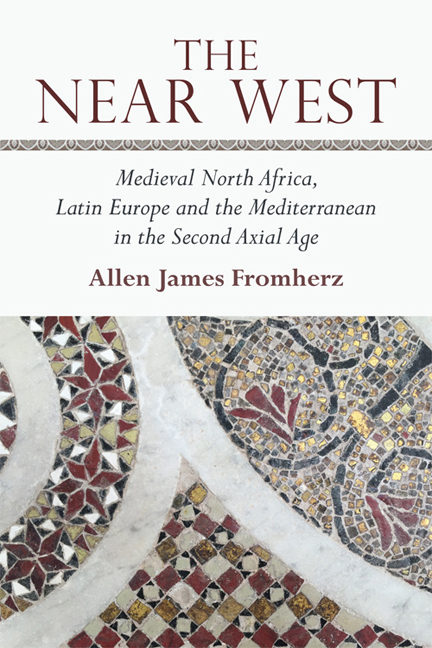Book contents
- Frontmatter
- Contents
- Map: The Near West – Medieval North Africa and Europe
- Personal Note and Acknowledgments
- Introduction: North Africa and the Mediterranean Paradox
- 1 Bèjaïa: Introducing North Africa, Latin Europe and the Mediterranean
- 2 Rome: North Africa and the Papacy
- 3 Tunis: Axis of the Middle Sea
- 4 Marrakech: The Founding of a City
- 5 The Almohads: Empire of the Western Mediterranean
- 6 Between City and Countryside: Ibn Khaldun and the Fourteenth Century
- 7 Conclusions: A Second Axial Age
- Notes
- Bibliography
- Index
7 - Conclusions: A Second Axial Age
Published online by Cambridge University Press: 23 September 2017
- Frontmatter
- Contents
- Map: The Near West – Medieval North Africa and Europe
- Personal Note and Acknowledgments
- Introduction: North Africa and the Mediterranean Paradox
- 1 Bèjaïa: Introducing North Africa, Latin Europe and the Mediterranean
- 2 Rome: North Africa and the Papacy
- 3 Tunis: Axis of the Middle Sea
- 4 Marrakech: The Founding of a City
- 5 The Almohads: Empire of the Western Mediterranean
- 6 Between City and Countryside: Ibn Khaldun and the Fourteenth Century
- 7 Conclusions: A Second Axial Age
- Notes
- Bibliography
- Index
Summary
Ibn Khaldun experienced profound angst and internal conflicts between spiritual enlightenment and the appeal of worldly power. In this way, he reflected a much larger trend in the medieval Mediterranean. The conflict between money, power and spirit, the simultaneous rise of both a commercial revolution and a spiritual revolution on all shores of the Western Mediterranean, was one of the most defining struggles of the medieval world. Ibn ‘Arabi, for instance, was the great Unlimited Mercifier who, coming from the Almohad West, transformed the Islamic world with his teachings and spiritual exercises, far from the realm of political power and its allures. His followers and disciples as well as the disciples of many more Sufi saints spread throughout the Islamic world, following trade routes deep into Eurasia and Africa. St. Francis, and many others, similarly rejected worldly goods, war and the life set before him by his father and by society. Strategically embraced by the Church, his movement and his friars, from William of Rubruck to Lorenzo of Portugal, Lope d’Ayn, spread out through the known world, from Marrakech to the Mongols, following the mercenaries and merchants whose fortunes were being made with the rise of global trade. Yet along with this trade and new wealth, for both merchants and rulers, came profound spiritual crisis.
In the period covered by this book, roughly between 900 and 1450, and especially in the twelfth century midpoint, major religious traditions throughout Eurasia and North Africa, well into the Sahara, experienced a great spiritual transformation. The rise of commercial wealth and trade and the interactions between different faiths it caused sparked this spiritual revival. This could be called a Second Axial Age: a world historical transformation marked by profound changes and encounters both within and between matured religious traditions and cultures. While conflict has often been downplayed in favor of studying tolerance and commercial exchange, informed recognition of, and then reaction to, other, rival religious traditions characterized this age.
Rather than being marked only by passive dismissal, tolerance or crosscultural conversion, encounters between different universal faiths provoked profound changes and reactions within those very traditions. Although the “dream of conversion” was not always the central concern, it could lead to angst.
- Type
- Chapter
- Information
- The Near WestMedieval North Africa, Latin Europe and the Mediterranean in the Second Axial Age, pp. 209 - 225Publisher: Edinburgh University PressPrint publication year: 2016



